I have a frustrating childhood memory of playing Pokemon Red on my flea market GameBoy Advance at 5am. Right after you start the game, there’s the Viridian Forest. I encountered lots of cool bug type Pokemon—and one of the hardest challenges to 7 year-old Finn’s resilience:
Metapod and Kakuna are Pokemon whose only move is Harden, which ups their defense, making them take less and less damage from my Charmander’s (the correct starter choice, sue me) only offensive move, Tackle. I had to tackle them, over and over and over and over again, barely chipping away at their seemingly infinite health bar.
That’s what it’s like trying to disrupt Excel. Excel is the Metapod of software: No amount of SaaS startups, venture funding or disruption seems to dent Excel’s dominance. It sticks around with its 750 million users in tow, impossible to beat into submission.
This is happening even while much of Microsoft Office has effectively been disrupted. I can’t remember the last time someone sent me a .docx or .pptx file. Sure, much of this has moved to Office 365, but the alternatives to Word & PowerPoint seem to have a better foothold in the market than Excel alternatives. Excel seems to shake off every revolution in business software.
If you widen your perspective outside of tech companies, Excel is even more dominant. So many businesses exist on the back of a giant Excel file no one understands, takes 5 minutes to open and was created by a guy called Jerry who quit 7 years ago.
This dynamic has turned Excel as a reference point for startups: Want to build a SaaS app? Find something people build complicated Excel files for, then build a SaaS app that makes that easier. This has created enormous enterprise value:
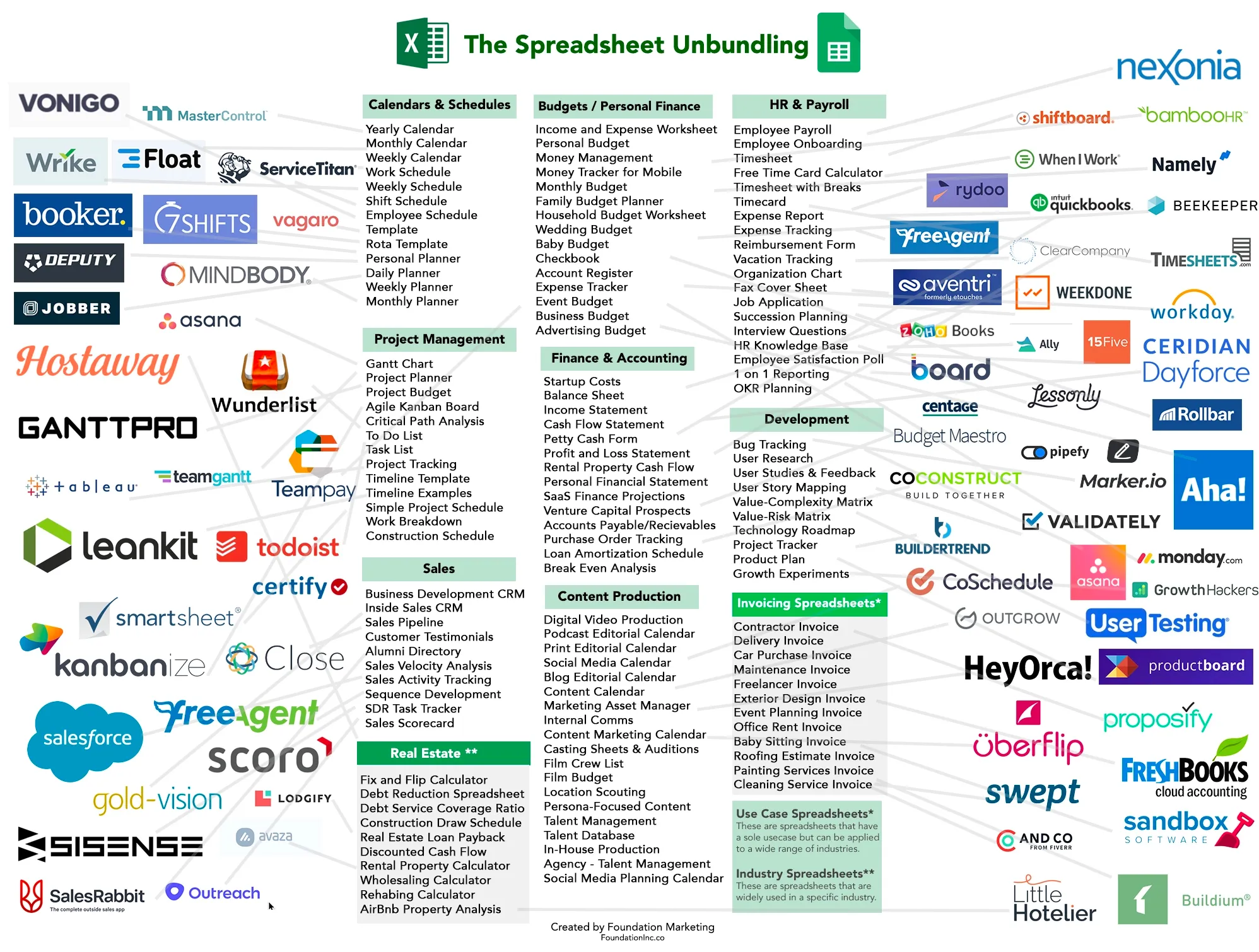
This graphic is a few years old, so you could add many more. But this unbundling of Excel has also created a problem: So. Many. Dashboards. If you work in a product/growth function, you know what it’s like to jump between 7 (often mediocre) dashboards just to write a 500 word memo.
It’s clear that Jerry’s master monster spreadsheet that takes minutes to open isn’t optimal. But it’s also clear that spreadsheets aren’t going anywhere.
Today, we’re looking at 2 startups doing exactly that. To start, we’ll analyze Excel as a product, then we’ll look at how they’re aiming to revolutionize the spreadsheet. Let’s go.
(Note: Most of these articles ignore the bundling economics of being included in Microsoft's Office 365 suite, which gives it a enormous distribution and pricing advantages. In keeping with the tradition, I'll also ignore it. That's not because I'm unaware of it, but because it goes beyond the scope of this article, which is focused on products and their users specifically.)
Why Excel dominates
I’m not breaking any new ground here. Writing about Excel is its own little genre. Tom Tunguz’s The Unbundling of Excel, Ross Simmond’s The SaaS Opportunity of Unbundling Excel and, more recently, Excel never dies.
These are great articles and I won’t repackage their conclusions. They can be summarized as: Excel is undergoing a decades-long unbundling.
But few have analyzed Excel through a product lens. So let’s do that.
Spreadsheet’s jobs to be done
At its core, spreadsheet software does four things:
- Data input
- Data storage
- Data manipulation
- Data display
Excel does all of these: It lets you enter data into cells, stores it in an .xslx file, lets you set up simple to complex calculations and displays the results either as a spreadsheet or as basic charts.
But features aren’t jobs to be done. If you’re a product manager, the job to be done of a given spreadsheet might be to share your product’s good performance with your manager.
Because you can kinda-sorta do anything with Excel, this means that its jobs to be done are basically infinite.
Excel is so wide
Since most product analysis starts with jobs to be done, let’s start there. In the user assistance space, use cases are limited. Nobody’s using in-app messaging for project management. Excel is the opposite. Its use cases are practically infinite.
You can use Excel for inventory management, financial planning, marketing analytics, project management, CRM, calorie counting, wedding planning… you name it!
While I suspect few are using Excel for calorie counting nowadays, this makes it hard to call yourself an “Excel alternative” without just building an Excel copy with fewer functions.
People like Excel
The typical SaaS startup goes something like this: Find an incumbent product disliked by its users (or at least a segment of its users). Build an alternative that serves those users’ needs better.
At CommandBar, we’re trying to disrupt the digital adoption space with user assistance. We look at what users dislike (annoying pop-ups, useless guidance) and how that affects companies (lower retention, activation, engagement).
So we’re building something better for users and companies. This is based on understanding jobs to be done: Once we know what people want to do, we can design a solution to cater to those needs.
But people like Excel. Check out this G2 grid:
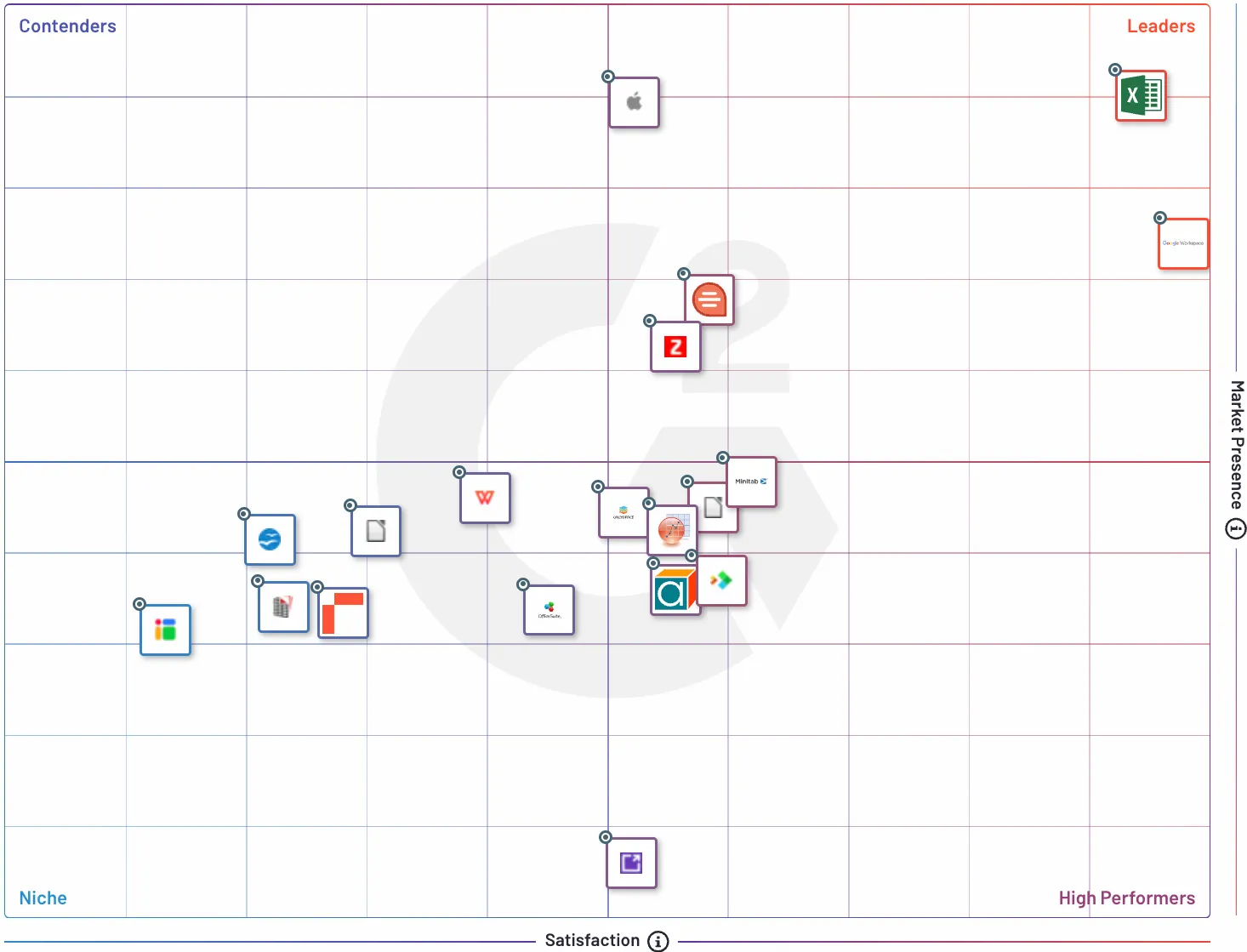
This is also true anecdotally. People I know in finance/consulting don’t see Excel as a sclerotic incumbent’s tool forced upon them by their employer. They see Excel as a great tool for their job.
Many incumbents dominate because they’re bad. But some incumbents dominate because they’re good.
That’s one part of why it’s hard to disrupt Excel—most of its core users don’t want an alternative.
Excel is higher stakes
Excel’s use cases are usually higher stakes than those of Word and PowerPoint.
Getting something wrong in a press release (Word) or missing a bullet in a deck (PowerPoint) is a temporary embarrassment. Getting your company’s financial model wrong can mean permanent bankruptcy.
This makes switching from Excel feel risky—will the 5 dependencies between different formulas hold if I switch vendors (especially when that vendor is a startup)? Compare that to text processing: You can paste a Word document into Notion and know the content is the same.
We’ve seen the same at CommandBar. Early on, many prospects liked our product, but didn’t want something as crucial as onboarding to be provided by a young startup. (This has gotten much easier to handle as we’ve grown and got more proofpoints like customer logos, SOC 2 status, etc.)
But this is just a subset of the fact that Excel has higher switching costs.
Why Excel’s switching costs are high
As mentioned before, Excel does a lot of things. It stores your data and houses complex calculations with interdependencies. Those files can become practically impossible to replace. This creates switching costs.
Note: Switching costs are a competitive advantage described by Hamilton Helmer. They describe how hard it is to switch from a product to a competitor. To-do list apps have notoriously low switching costs (just finish your list and switch). Infrastructure has high switching costs because switching infra means rebuilding your entire product.
Because you can build almost anything in Excel, this isn’t true for all Excel use cases. You could use Excel as a to-do list, which gives it low switching costs.
Switching costs increase retention, but also have a downside:
Switching costs as an Achilles heel
High switching costs make product categories in slow motion. Even dissatisfied users stick around, so markets move slowly. When cohorts stick with your product for years (for better or worse), they won’t switch within weeks.
But if a cohort prefers the upstart’s alternative, it means they’ll use that product forever. This undermines a strong market position over the long run. Old cohorts might be cash cows until they retire. But without new cohorts, a product can look like landline phones: The old generation never stops using them, but the decline is unstoppable.
As long as new investment bankers are still trained on Excel for 80 hours a week, it’s probably fine. If that changes, Excel could be in trouble.
The fact that bankers are my go-to example for Excel users is a sign of this—Excel is no longer the standard for startups’ calculations (we’ll look at some replacing it).
Excel has no opinion
If Carta miscalculated an investor’s equity, you could complain about it on Twitter and squeeze an apology out of their marketing team. If you tweeted at Microsoft about your homegrown Excel sheet’s miscalculations, you’d be ridiculed until you apologize.
Excel is the antithesis to what Linear calls ‘opinionated software’. Excel doesn’t care what you build. It spits out the result according to your input. This makes Excel look more like a programming language than an app: If you have a data dump, a table of calculations and a page with visualizations, that’s a database, backend and frontend.
Microsoft has no idea (and doesn’t care) what people build with Excel. This positions it similar to Figma: You can build anything, so it’s hard to replace.
When your users realize “Oh I can just use this tool I already know”, retention and engagement increase.
But it’s precisely this market position that startups exploit.
The startups coming for Excel
Excel has infinite potential use cases, but isn’t perfectly suited for most of them. That’s why “the unbundling of Excel” creates so much enterprise value: Excel is a passable to-do list, but not as good as a tool specifically for that purpose.
This is classic disruption theory. From The Product of Lenny:
Clayton Christensen’s theory of disruptive innovation is simple:
Incumbents create “sustaining innovations,” which meet most people’s needs okay-ish. The incumbent’s scale advantages mean they’ll generally win against startups. Some people have higher standards the incumbent won’t meet. That’s because their scale makes the opportunity is too small to pursue. Startups can beat the incumbent by meeting that segment’s needs better and then shooting past the incumbent.
Wherever Excel is okay, but not perfect, a purpose-built app can disrupt that specific Excel use case. That’s why Excel has already been effectively disrupted for B2C use cases (when was the last time you heard someone use an Excel sheet in their daily life?)
For B2B-B2C hybrids, this has happened in project management, to-do lists and so many other vectors. But no startup has succeeded in coming for the B2B spreadsheet itself, and most have stopped trying. But not all.
A few startups’ products now argue that it’s not just some spreadsheet use cases that deserve disruption, but the spreadsheet itself. Let’s look at 3 of them through the lens of Excel’s core use cases: Data input, storage, manipulation and display.
(Note: I could writ a full essay on each product below. To keep this from becoming a novel, I’ve omitted numerous UX improvements and features that distinguish them from Excel.)
1. Equals: Internet-native Excel
Craft Ventures GP David Sacks described Equals as “what Excel would be if it were built today”. It’s powerful and clearly caters to people who work with spreadsheets. Look at their home page messaging:
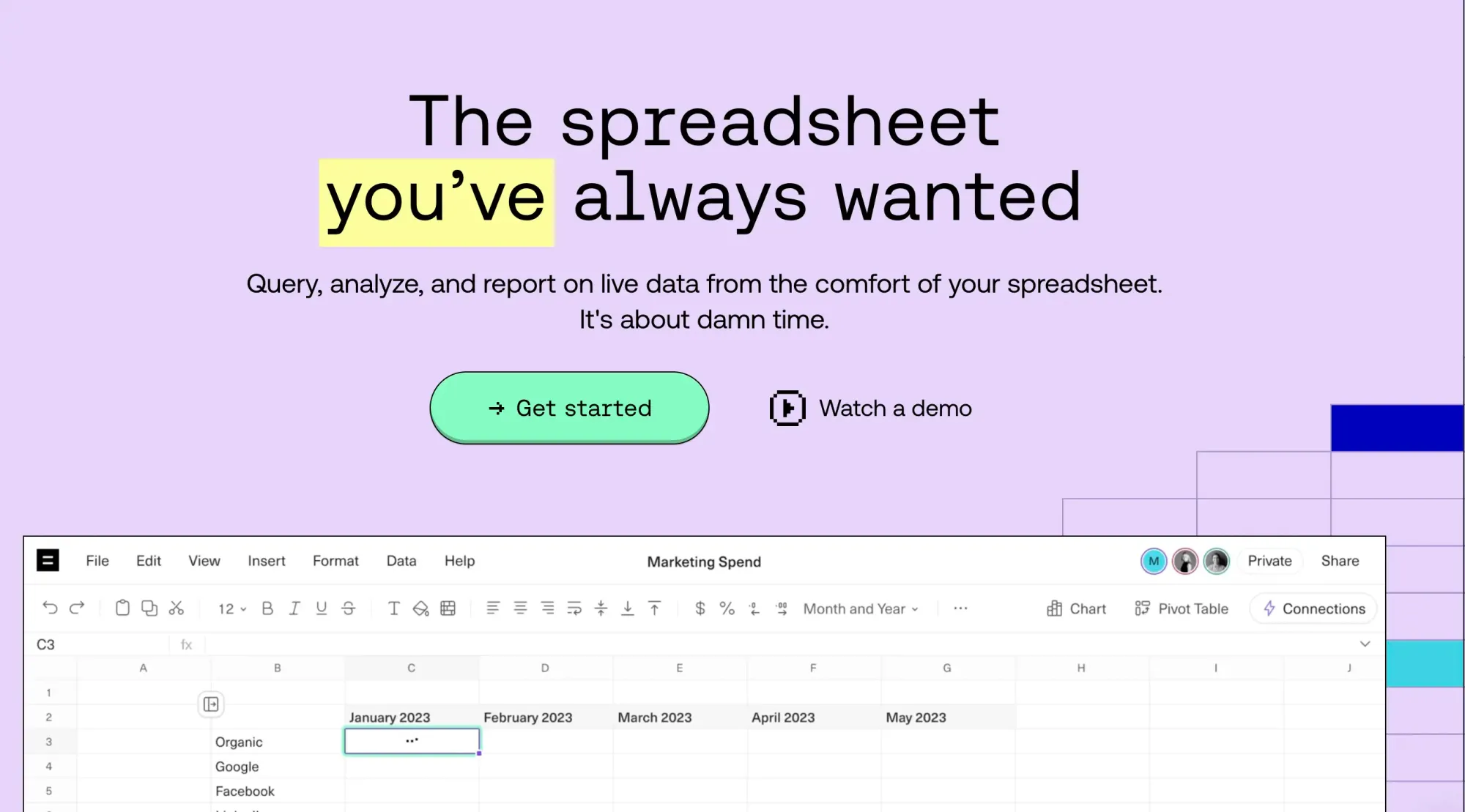
As a creative guy, I can assure you there’s no spreadsheet I’ve always wanted. And I derive as much comfort from my spreadsheet as I do from stepping on Lego bricks.
Equals’ positioning harkens back to the fact that Excel is mostly reduced to sophisticated B2B use cases. While the product is universal, it clearly aims at data, finance and operations teams.
Equals accomplishes Excel’s use cases differently:
- Data input: You can input data manually (like you would in Excel). But this is one of the core pain points of Excel users. That’s why the main way you get data into Equals is via integrations. The product manually integrates with analytics platforms, data warehouses and many others. Or, as they put it on their website: No more downloading CSVs or copying and pasting queries. Thank f$ck.
- Data storage: Dumping tons of data into a giant Excel spreadsheet slows the product down, which makes UX worse. Equals has an advantage here: It only imports the data it needs from connected sources. This improves the UX while still giving you full access to your data.
- Data manipulation: While I’m not Excel power user, I imagine Equals at least has parity with Excel on formulas and other manipulation. Connecting disparate data sources does enhance manipulation by making data more composable: Without a tool as well-connected as Equals, it’s hard create formulas that incorporate both LinkedIn ad performance and Salesforce data.
- Data display: Excel can generate many different charts—and Equals rivals its functionality. But Excel visualizations are somewhat more clunky and require opening the Excel file. Equals directly integrates with Slack, Email and Slides and can automatically share charts there.
This final point reveals that Equals understands an important truth about the spreadsheet category: Spreadsheets do these four things, but they affect more. Even the best dashboard is pointless when it’s not distributed and doesn’t drive decisions.
That’s ultimately where businesses derive value from data: In improved strategic decision-making and execution.
2. Rows: Work better with numbers
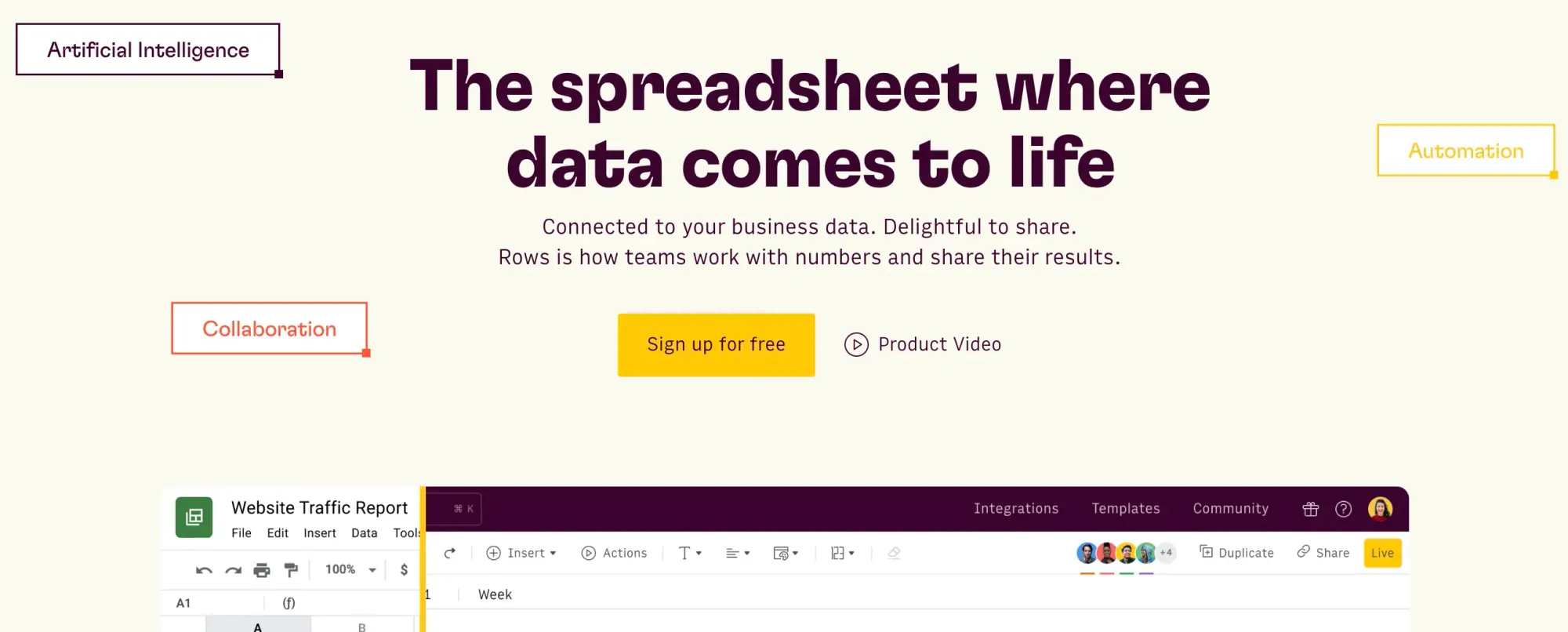
If Equals is a spreadsheet for data, finance and ops professionals, Rows is for teams—no matter how sophisticated they are.
- Data input: Rows also integrates with various data providers, but also offers the RowsX Chrome extension, which lets you add data from any website (e.g. a Y Combinator search) and directly turn it into a spreadsheet. This enables teams to work with public data they never had because it’s so hard to source. Here's an example:
- Data storage: The integrations give Equals the same advantage as Equals: They provide access to all the data without the responsibility of storing all the data. But RowsX offers an extra advantage: RowsX data is hard to obtain, so Rows gains an advantage in making it easy to store that data (which is unlikely to be so much that it slows the whole app down).
- Data manipulation: The benefits here are similar to Equals’, but Rows seems to cater slightly more to sophisticated users by offering simple wizards for complex calculations. This means power users feel at home without alienating people who aren’t Excel wizards.
- Data display: You can embed live Rows visualizations anywhere by simply posting a link. This makes it easy to share reports with your team without having to manually update them or version-control your screenshots.
Rows’ product vision seems to argue that Excel’s complex use cases made spreadsheets inaccessible to many segments—even when a good spreadsheet would create massive value for them.
3. Causal: Financial planning as a beachhead

Causal takes a different approach. Instead of building general-purpose spreadsheets from the get-go, their product is a point solution for financial planning. This is an astute strategy: Causal is starting with Excel’s power users—finance and operations professionals. In contrast to Rows and Equals, Causal is opinionated and spells out specific use cases.
This makes sense: As discussed previously, most of Excel’s non-finance/modeling use cases are already disrupted.
While the input-storage-manipulation-display model fails us here, I wanted to include Causal because they’re taking a different approach that could lead to the same outcome.
This means their initial use case is that with the highest switching costs. It attacks Excel where it’s most entrenched. Gaining these users is hard, but has two advantages:
- It offers the highest rewards: Switching costs and a high-stakes use case make this the most valuable segment and implies a high willingness to pay.
- It front-loads effort: Building sophisticated use cases is hard. If you were to bolt on these sophisticated use cases later requires long lead times for something uncertain.
In Crossing The Chasm jargon, this would be a “beachhead segment” from which Causal can expand. This strategy is similar to PayPal starting with eBay power sellers before becoming a universal payments provider.
It’s easy to imagine Causal expanding to other use cases within companies and replacing them that way, becoming a more universal spreadsheet over time.
The world after Excel
All of these startups differ from Excel in a major way: They’re dispensing with being a crude programming language and are “just” **spreadsheets.
Rows and Equals are decidedly not data storage platforms. They unify data from different sources and let you turn it into spreadsheets—including mixing data. They’re not replacing Excel, but creating a universal custom dashboard.
This turns them into a single source of truth—exactly what Excel became, but without all the things we don’t need anymore.
Take marketing analytics as an example. The current world looks like this:
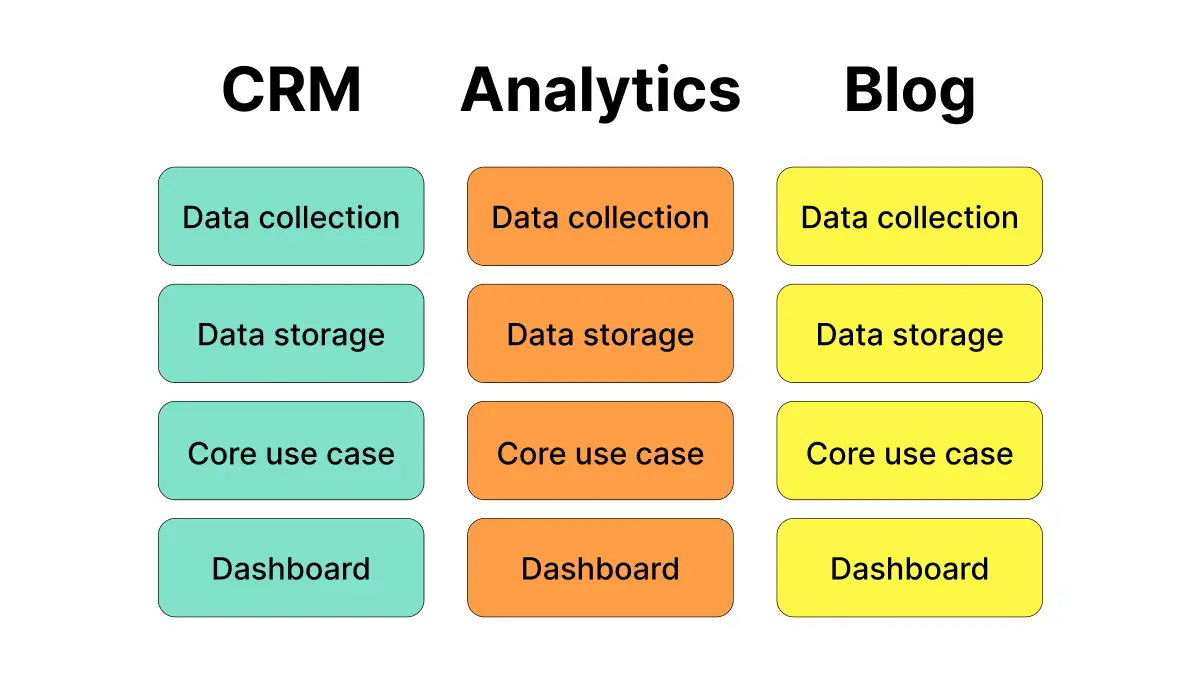
In a post-Excel-disruption world, that might look like this:
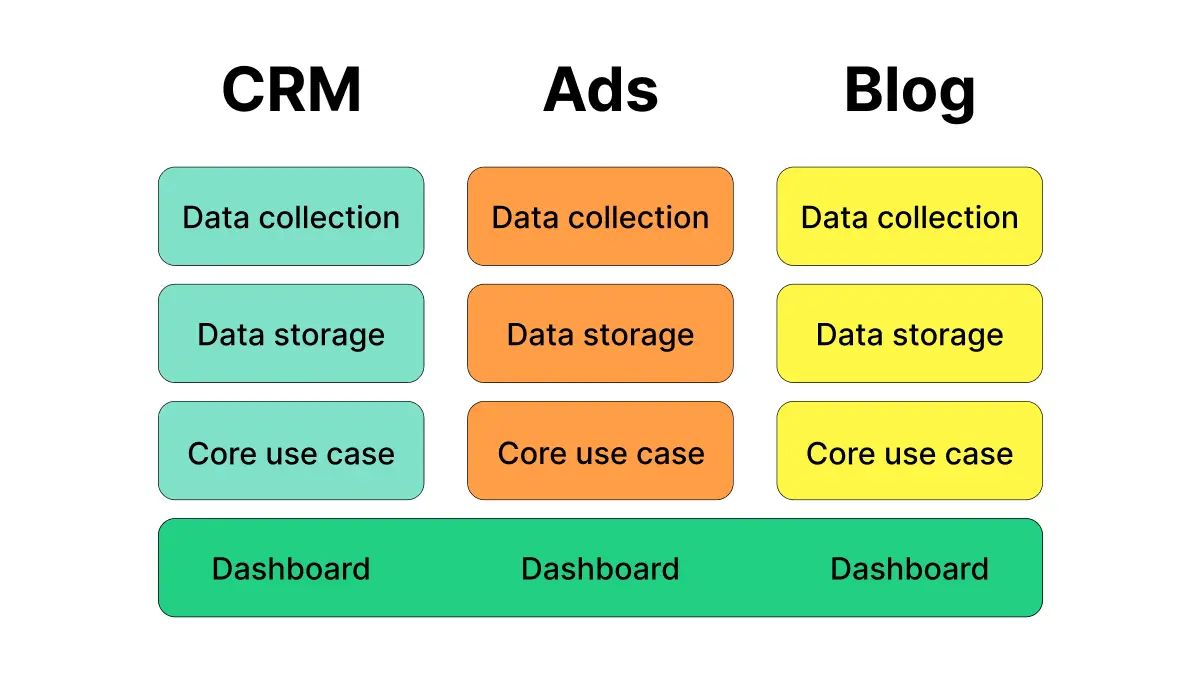
If this strategy succeeds, this would make novel spreadsheet software a complement to many SaaS products: Users can dispense with dozens of dashboards while software companies can skip building visualization and dashboard features.
This is similar to something we pursue at CommandBar: We want to build a universal interface layer, at least for what’s standardized across software. This creates a net benefit for everyone involved. Users have a great experience with software tools. Software companies don’t have to spend years building great UX. And we get ever more data to build ever better interfaces.
Can this post-Excel model work? The biggest question is whether companies are willing to make user-generated data available via API. While the software world becomes more and more interconnected, it’s easy to imagine a company restricting access to the data its users generate.
Not having to build visualization/analytics is great for some companies, but it could also be risky: If users build nonsensical spreadsheets and get bad results from their data incorrectly, that might mean they incorrectly conclude they need to cancel one of the products producing that data.
This is where apps like Causal have an advantage: When users have to build a specific use case, they’re less likely to mess it up.
But can they cross the chasm?
These startups are gaining traction, mostly within tech. But being a startup with traction isn’t enough to disrupt something as massive as Microsoft Excel.
To become a billion-dollar success usually requires going mainstream, you need to cross into the mainstream, which requires entirely different skills than selling to other startups.
It’s great if a trendy startup uses Equals for their spreadsheets. But disrupting Excel means becoming the default for HVAC companies in Idaho, accountants in Bangalore and dentists in Frankfurt.
In the tech industry, we have the resources and interests in new and elegant solutions. We’re genuinely interested in new software. Most people aren’t. They view software like we view hammers, buzzsaws and garlic presses: Tools to get something done.
Both Rows and Equals have an advantage here: Their core UI patterns mirror Excel’s—rows, columns, formulas.
Small businesses don’t have 7 data sources they want to look at more efficiently. But they do want an overview over their business. And even small, local businesses are using more and more SaaS tools: Squarespace, Quickbooks, etc.
If Equals/Rows can make it easy to become that single source of truth, these cloud-native spreadsheets might succeed in becoming the new default.
Will this kill Excel?
Predicting the death of Excel is like predicting the death of email: An article about it goes viral, people become more and more certain it’ll happen… and then it doesn’t.
Microsoft Office is still the standard in many companies big and small. Hordes of banking interns and junior consultants spend 80 hours a week in Excel (maybe hoping to compete in Excel as an eSport).
Yet, like the cocoon Pokemon in Viridian Forest, each little tackle wears them down. And so does the SaaS industry chip away at Excel’s dominance. With each tool better suited for a certain task, there’s one less market segment defaulting to Excel.
My guess is that what the internet is doing to most incumbents will happen to Excel: It moves to the extremes. Those with super simple needs (e.g freelancers) will use Excel, as will those with incredibly sophisticated needs (e.g. financial analysts).
If startups start in a niche before expanding to fill ever more space, Excel is a reverse startup: Starting as the default for everything and retreating into ever smaller niches.
Excel won’t die anytime soon. But it’s also clearly a software of the previous generation, built on the primitives of relatively small, locally hosted datasets, single player usage and on-device installation. Microsoft has remedied this to an extent (e.g. by making MS Office available in the cloud), but these foundations are still in Excel’s “genetics”. Can those genetics evolve enough for a cloud-native software landscape with big data? We’ll see.














